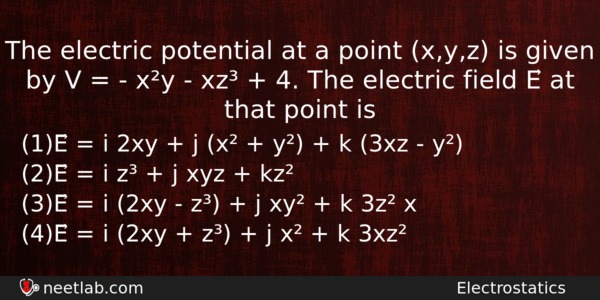| ⇦ | 
| ⇨ |
The electric potential at a point (x,y,z) is given by V = – x²y – xz³ + 4. The electric field E⃗ at that point is
Options
(a) E⃗ = i 2xy + j (x² + y²) + k (3xz – y²)
(b) E⃗ = i z³ + j xyz + kz²
(c) E⃗ = i (2xy – z³) + j xy² + k 3z² x
(d) E⃗ = i (2xy + z³) + j x² + k 3xz²
Correct Answer:
E⃗ = i (2xy + z³) + j x² + k 3xz²
Explanation:
The electric field at a point is equal to negative of potential gradient at that point.
E⃗ = – ?V/ ?r = [ -?V/ ?x i – ?V/ ?y j – ?V/ ?z k ]
E⃗ = i (2xy + z³) + j x² + k 3xz²
Related Questions: - A small signal voltage V(t)=V₀ sin ωt is applied across an ideal capacitor C
- The maximum particle velocity in a wave motion is half the wave velocity.
- When a ball is thrown up vertically with velocity vₒ,it reaches a maximum height
- The work function of metals is in the range of 2 eV to 5 eV.
- An object is placed at a distance of 10 cm from a co-axial combination of two lenses
Topics: Electrostatics
(146)
Subject: Physics
(2479)
Important MCQs Based on Medical Entrance Examinations To Improve Your NEET Score
- A small signal voltage V(t)=V₀ sin ωt is applied across an ideal capacitor C
- The maximum particle velocity in a wave motion is half the wave velocity.
- When a ball is thrown up vertically with velocity vₒ,it reaches a maximum height
- The work function of metals is in the range of 2 eV to 5 eV.
- An object is placed at a distance of 10 cm from a co-axial combination of two lenses
Topics: Electrostatics (146)
Subject: Physics (2479)
Important MCQs Based on Medical Entrance Examinations To Improve Your NEET Score
18000+ students are using NEETLab to improve their score. What about you?
Solve Previous Year MCQs, Mock Tests, Topicwise Practice Tests, Identify Weak Topics, Formula Flash cards and much more is available in NEETLab Android App to improve your NEET score.
Share this page with your friends

Leave a Reply